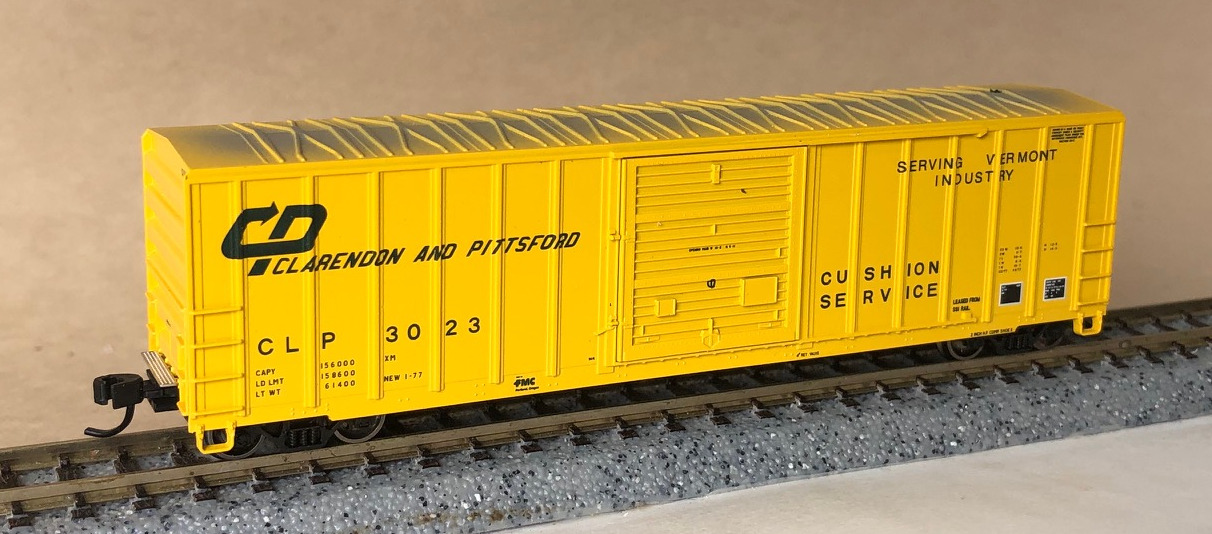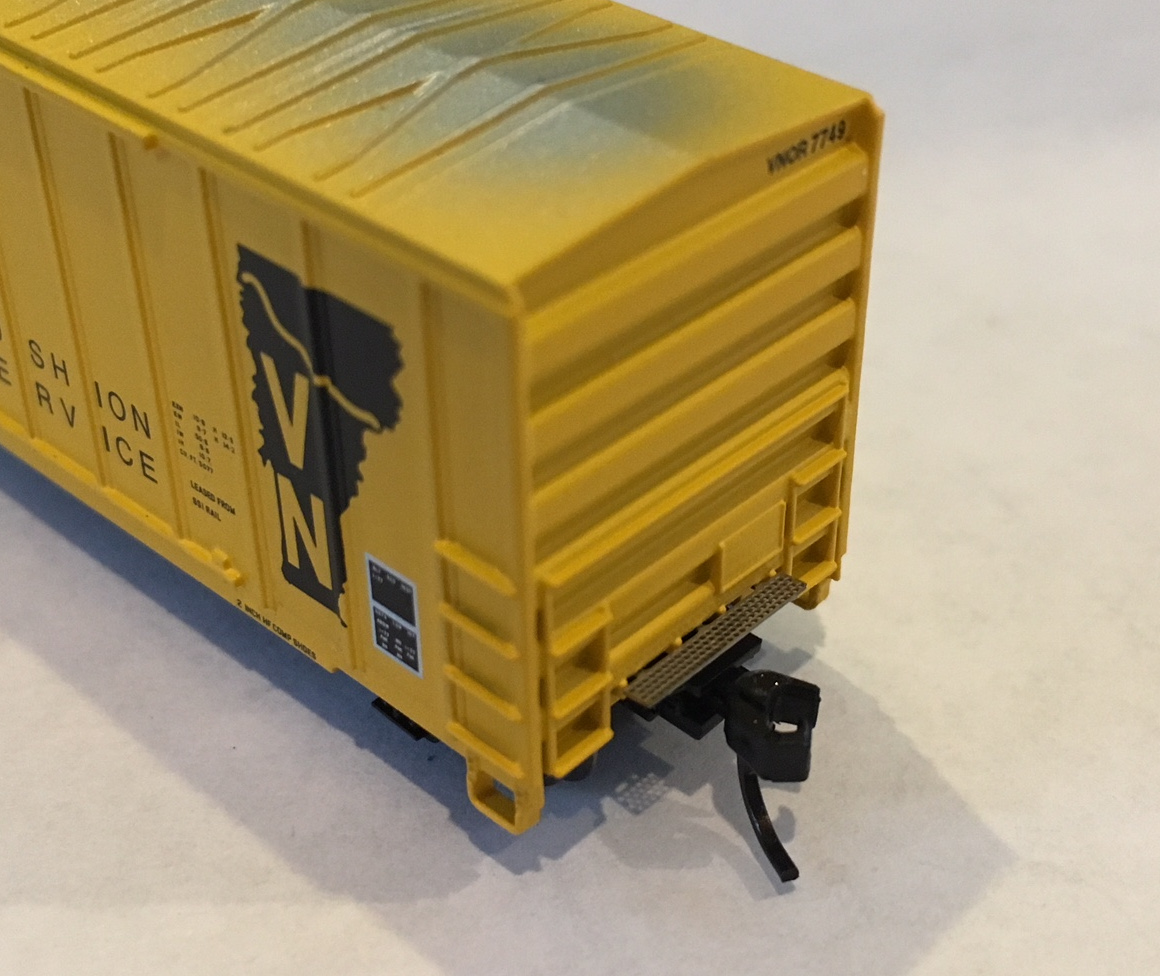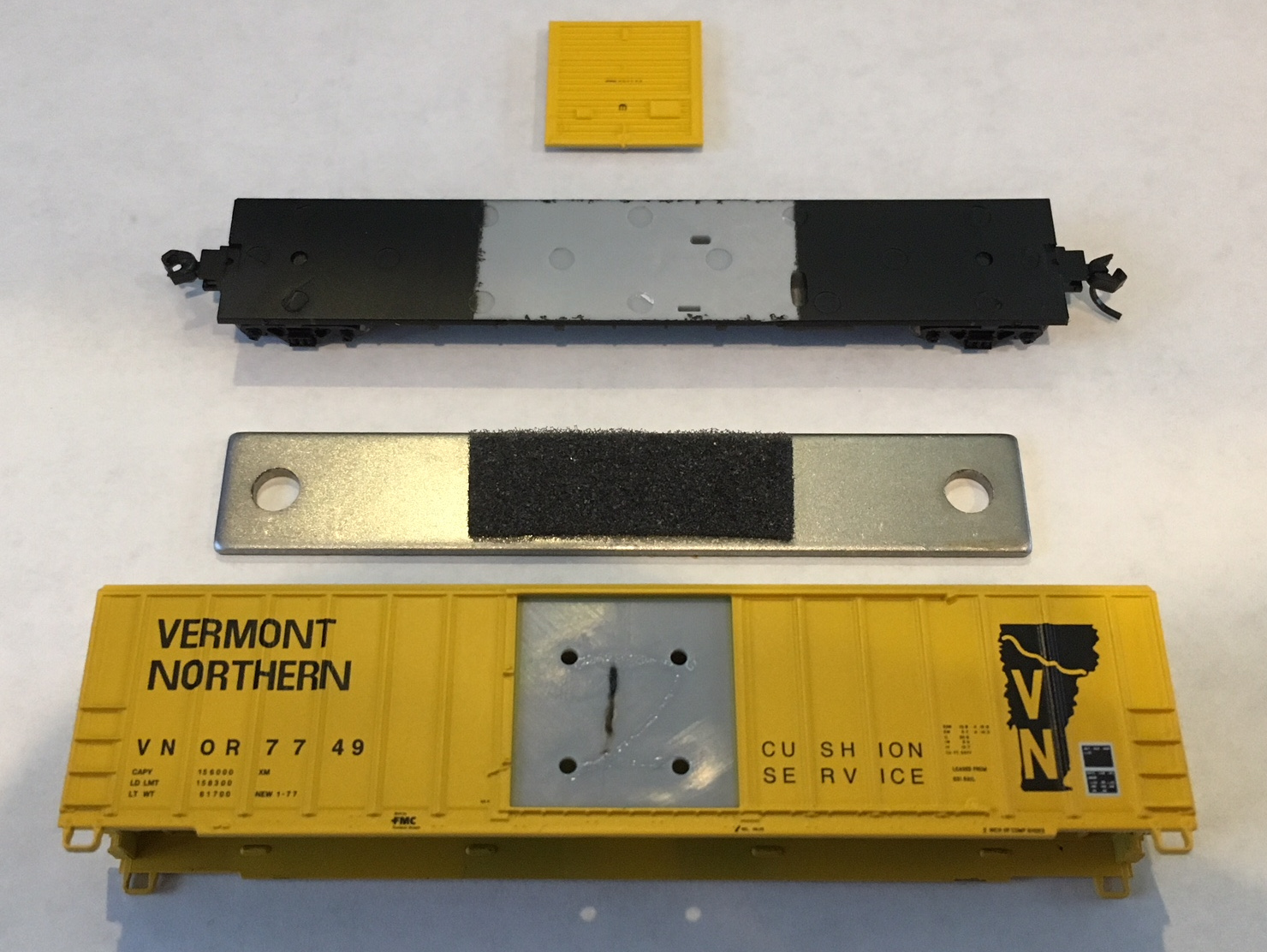Atlas FMC 5077 Boxcars
Published: 2018-01-19 - By: gdm
Last updated on: 2021-07-28
Last updated on: 2021-07-28
visibility: Public

When you model New England, life is sometimes a little tough. At TroveStar, we keep a sharp eye on what models are being produced, and we see many releases of prototypes for the Burlington Northern, Union Pacific, Santa Fe and even the Milwaukee Road. We watch these come out and we are in awe of the coolness of sets like Kato’s Hiawatha passenger set or Micro-Trains Santa Fe reefer packs. But we are also sad because we just don’t model these roads. Perhaps we should be grateful that our train budget isn’t stretched past the breaking point, but even so it is hard to appreciate this when we go to an N-Trak club meet (our local club is Northeast N-TRAK) and our fellow club members are running awesome models like the ScaleTrains.com Union Pacific GTEL Big Blow.
So it is a pleasant surprise when we see something like the new release of Atlas FMC 5077 Boxcars. These models are part of Atlas’ Master line of products. This means they are more highly detailed models than their down-market Classic and Trainman lines. That being said, these are very affordable. The MSRP on this latest release is $24.95, but we got ours from Top Hobby Trains for only $16.72 each. This price may seem a little high for us old-timers who remember buying rolling stock brand new for $3 to $5 each, but those times are gone. Inflation is partly to blame, but there is also the factor of rapidly rising labor costs in China, where these Atlas products are made. The days of sub-$10 rolling stock are gone (except for swap-meets and TroveStar Classifieds).
The recent release was the 2nd release of the single-door version of this model. There is also a double door version, but we consider this a different body style. The original release was made available in June of 2016 and this second release hit the shelves in January of 2018. The original release was given a $23.95 MSRP so the small increase to $24.95 represents Atlas passing on the increasing labor costs of production to the consumer.
First: a little about the prototype. This model is a typical 1970s and later 50 foot boxcar. FMC jumped onto the Per Diem boat in the 1970s and produced thousands of these things. Railbox bought a huge number of these as did a wide range of shortlines throughout North America. Thankfully this includes Vermont Railway (VTR), Clarendon & Pittsford (CLP) and Green Mountain (GMRC). Atlas also produced these for the big boys (they get everything don’t they?) so you can also get these models liveried for the Burlington Northern and CSX if you really want. Given the federal 50 year retirement rule, expect to see these continue to remain in service until the mid-2020’s. So if you model the modern era, these boxcars are just as much at home on your layout as they would be for a modeler of the 1970s or 1980s.

Note the etched-metal platforms and over-sprayed roof
These are excellent models. At TroveStar, we classify rolling stock as 1st, 2nd or 3rd generation. See our article on The Evolution of N-Scale Rolling Stock for more of an explanation. Suffice it to say that to qualify as a proper 3rd generation item is not easy for the manufacturers if they want to produce a budget product. So it is great to see a model qualify without any reservations and retail for under $20. So why does this model qualify? First off, it has metal wheels (check!) and body-mount couplers (check!). Next, it has more separately applied details than just the usual brake wheel. Specifically, you can spot the metal-etched end platforms easily as Atlas decided not to paint these to make them look more like the prototype. Well, I am sure these are a bit shinier than any you would ever see in real life, but these little end platforms are cool! Next (see photograph), the doors are not part of the mold. I actually pulled one off to see it in detail and I was impressed that Atlas would make a detail part for a non-operating door. This makes the model look a LOT more realistic. Next, I removed the underframe to see how it was constructed. It is very light and thin, and conceals a large metal weight held in by friction to the body shell. Now get this, Atlas added some foam between the metal plate and underframe. Why? I am not sure but I suspect this is to eliminate any rattle or vibration and make sure these cars run quiet. A very nice touch. Thank you Atlas.

Note the foam on the weight and the detailed door
We noticed one really nice element in the paint work. Atlas did the right thing and modeled ‘overspray’ on the roof. The Vermont Northern model I took apart is painted in yellow. The roof is a prototypically-accurate blend of yellow overspray and aluminum. The overspray affect occurred on the prototypes as the paint as applied from the sides and the manufacturer (FMC in this case) did not bother to mask the roof before spraying the sides. Hence slop spray would go onto the roof around the edges. The reasoning for this was that it wasn’t worth the additional labor and cost to mask the roof and most of the time the roof isn’t visible anyways. This really adds some punch to the model.
So what could be better? We are not rivet-counters here at TroveStar. We will leave that to the internet trolls. But we can see a few areas for improvement. First off, the underframe is somewhat lacking in detail. Compared to the Trainman caboose we received in the same order, these models’ underframes are underwhelming. Who sees the underframes? We do. We also suspect it is one of the first things most people see when they take the model out of the box. For the Atlas’ Master line, they could at last make an underframe as detailed as their Trainman Offset Cupola Caboose (an Atlas mainstay for almost 50 years).
So it is great that the door is a separately-applied detail, but given that, why couldn’t it be made operational? Atlas has made opening doors on other of their models. Since they went 90% of the way their by making a separate piece for the door, why couldn’t they do the small amount f extra work to make it slide open? Maybe that would have forced them to make the rails that the door slides on too wide and made the model look wonky. I can only guess. We also like to see separately applied ladders and grab irons, but this would blast the cost of production up several notches, so we can see why Atlas elected not to do this. Heck, we got our end platforms didn’t we?
This is a really nice model. When considering the price, this is an amazing model. Yes, Atlas could have done better with the detail, but then since they made a total of four different New England liveries (with three road numbers each) in this batch, we are kind of grateful the price was as low as it was.
So it is a pleasant surprise when we see something like the new release of Atlas FMC 5077 Boxcars. These models are part of Atlas’ Master line of products. This means they are more highly detailed models than their down-market Classic and Trainman lines. That being said, these are very affordable. The MSRP on this latest release is $24.95, but we got ours from Top Hobby Trains for only $16.72 each. This price may seem a little high for us old-timers who remember buying rolling stock brand new for $3 to $5 each, but those times are gone. Inflation is partly to blame, but there is also the factor of rapidly rising labor costs in China, where these Atlas products are made. The days of sub-$10 rolling stock are gone (except for swap-meets and TroveStar Classifieds).
The recent release was the 2nd release of the single-door version of this model. There is also a double door version, but we consider this a different body style. The original release was made available in June of 2016 and this second release hit the shelves in January of 2018. The original release was given a $23.95 MSRP so the small increase to $24.95 represents Atlas passing on the increasing labor costs of production to the consumer.
First: a little about the prototype. This model is a typical 1970s and later 50 foot boxcar. FMC jumped onto the Per Diem boat in the 1970s and produced thousands of these things. Railbox bought a huge number of these as did a wide range of shortlines throughout North America. Thankfully this includes Vermont Railway (VTR), Clarendon & Pittsford (CLP) and Green Mountain (GMRC). Atlas also produced these for the big boys (they get everything don’t they?) so you can also get these models liveried for the Burlington Northern and CSX if you really want. Given the federal 50 year retirement rule, expect to see these continue to remain in service until the mid-2020’s. So if you model the modern era, these boxcars are just as much at home on your layout as they would be for a modeler of the 1970s or 1980s.

These are excellent models. At TroveStar, we classify rolling stock as 1st, 2nd or 3rd generation. See our article on The Evolution of N-Scale Rolling Stock for more of an explanation. Suffice it to say that to qualify as a proper 3rd generation item is not easy for the manufacturers if they want to produce a budget product. So it is great to see a model qualify without any reservations and retail for under $20. So why does this model qualify? First off, it has metal wheels (check!) and body-mount couplers (check!). Next, it has more separately applied details than just the usual brake wheel. Specifically, you can spot the metal-etched end platforms easily as Atlas decided not to paint these to make them look more like the prototype. Well, I am sure these are a bit shinier than any you would ever see in real life, but these little end platforms are cool! Next (see photograph), the doors are not part of the mold. I actually pulled one off to see it in detail and I was impressed that Atlas would make a detail part for a non-operating door. This makes the model look a LOT more realistic. Next, I removed the underframe to see how it was constructed. It is very light and thin, and conceals a large metal weight held in by friction to the body shell. Now get this, Atlas added some foam between the metal plate and underframe. Why? I am not sure but I suspect this is to eliminate any rattle or vibration and make sure these cars run quiet. A very nice touch. Thank you Atlas.

We noticed one really nice element in the paint work. Atlas did the right thing and modeled ‘overspray’ on the roof. The Vermont Northern model I took apart is painted in yellow. The roof is a prototypically-accurate blend of yellow overspray and aluminum. The overspray affect occurred on the prototypes as the paint as applied from the sides and the manufacturer (FMC in this case) did not bother to mask the roof before spraying the sides. Hence slop spray would go onto the roof around the edges. The reasoning for this was that it wasn’t worth the additional labor and cost to mask the roof and most of the time the roof isn’t visible anyways. This really adds some punch to the model.
So what could be better? We are not rivet-counters here at TroveStar. We will leave that to the internet trolls. But we can see a few areas for improvement. First off, the underframe is somewhat lacking in detail. Compared to the Trainman caboose we received in the same order, these models’ underframes are underwhelming. Who sees the underframes? We do. We also suspect it is one of the first things most people see when they take the model out of the box. For the Atlas’ Master line, they could at last make an underframe as detailed as their Trainman Offset Cupola Caboose (an Atlas mainstay for almost 50 years).
So it is great that the door is a separately-applied detail, but given that, why couldn’t it be made operational? Atlas has made opening doors on other of their models. Since they went 90% of the way their by making a separate piece for the door, why couldn’t they do the small amount f extra work to make it slide open? Maybe that would have forced them to make the rails that the door slides on too wide and made the model look wonky. I can only guess. We also like to see separately applied ladders and grab irons, but this would blast the cost of production up several notches, so we can see why Atlas elected not to do this. Heck, we got our end platforms didn’t we?
This is a really nice model. When considering the price, this is an amazing model. Yes, Atlas could have done better with the detail, but then since they made a total of four different New England liveries (with three road numbers each) in this batch, we are kind of grateful the price was as low as it was.

